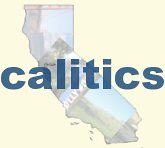California's Reverse Stimulus and How To Reverse The Reverse
The national media is starting to pick up on the developments with the California budget, and their potentially devastating impact on the larger economy. Bloomberg has an article on the shutdown of infrastructure projects and the impact statewide:
Just $5 million of work is needed to complete a new California Court of Appeals building in Santa Ana. The state may not have the money, and come July judges may be writing opinions in their living rooms.
“I’ve been on the bench for 23 years, and I’ve never seen anything like this,” said David G. Sills, the presiding justice for the Fourth District Court of Appeals, Division Three, in a telephone interview.
California’s worst budget crisis has held up $3.8 billion in spending on public works, possibly including the courthouse adjacent to Santa Ana City Hall. Sills and his seven fellow jurists had planned to move in before the lease on their temporary offices expires June 30.
“Everyone will have to work from home,” said Sills, 70, “and we’ll have to rent a place for when we hear arguments.”
The story ticks off all of the projects lying unfinished - highway improvements, bridge and levee repairs, a hospital at San Quentin, a middle school in South Gate. The delays are not only a threat to the soaring unemployment rate and the state's economic future, but public safety.
South of downtown Los Angeles, a delay finishing a school building could put children in danger, said German Cerda, principal of South Gate Middle School. About a third of his 2,900 students are scheduled to move into the new building a half-mile away in 2012, relieving overcrowding inside and making nearby streets safer, he said.
On Dec. 2, a 14-year-old South Gate student was killed when a car stuck him a block away, an accident Cerda attributed to congestion.
“The biggest complaint we get from parents is what happens when the bell rings at 2:42 p.m. each day,” Cerda said. That’s the time that his students are dismissed and 3,000 more are leaving a high school down the street. “They don’t want to see another tragedy.”
Then there are the expected cuts to state Medicaid programs, at precisely the time when more Californians qualify for services.
Among the states with the gravest financial problems -- and pressures on Medicaid -- is California. In July, Medi-Cal, as the program there is known, slashed by 10 percent the rates it pays hospitals, nursing homes, speech pathologists and other providers of health care. It tried to lower payments to doctors and dentists, too, but they have sued to block the decreases.
Gov. Arnold Schwarzenegger (R) has asked the state legislature to approve other cuts, including an end to dental care for adults, about 1 million of whom use it now, and a sharp reduction in care for recent immigrants.
At two hospitals run by NorthBay Healthcare, midway between San Francisco and Sacramento, about one patient in five is on Medi-Cal. The rate cuts translate into a $4 million loss this year. In September, the health system closed a rehabilitation program for children that provided physical therapy, speech therapy and other help to about 300 young patients at a time -- with 100 more usually on the waiting list.
"It was heart-wrenching to have to go out and announce," said Steve Huddleston, NorthBay's vice president of public affairs.
The Obama campaign is weighing options for both backfilling Medicaid for the states and jump-starting infrastructure spending through cash infusions. However, the biggest thing the federal government could do right now is what John Chiang describes in a letter to the Obama transition team and California's congressional delegation - guarantee the financing for infrastructure projects. The reason they cannot be funded right now is that the market for revenue anticipation notes and bonds is locked. Though California has never defaulted on these securities, investors are nervous that the careening budget crisis will cause them to do so. So putting the full faith and credit of the US government behind the notes, which if California does repay its creditors would cost the feds next to nothing, would immediately allow the infrastructure projects to begin again. That's the short version - here's Chiang with the greater plan, including incentives for banks to lend.
This proposal is simple, straight forward and cost effective:
1) Develop a federal guarantee program of limited duration for state and local debt issued to fund new infrastructure construction and renovation. Each state could designate a state commission or agency to disburse the state’s allocation of federal guarantees in accordance with the program guidelines;
2) Allocate these benefits, or guarantees, in the amount of $500 to $1,000 per capita to states. The allocations can be based on unemployment or 2000 census population, with a minimum “baseline” allocation to low-population states; and
3) Furthermore, the proposal would greatly benefit from abolishing the limit on the amount of deductible interest costs for commercial banks related to the purchase of these particular state and local infrastructure bonds during the term of the program. This restriction has been in place since enactment of the Tax Reform Act of 1986.
This would mean the restoration of up to 200,000 jobs in California alone, as well as $16 billion in economic activity. Those are numbers that an incoming Obama Administration cannot afford to lose as they begin implementing a recovery package.
Obviously, the biggest remedy to show confidence to the markets and gets the lending flowing again would be to pass a budget and prove to investors that California is getting its financial house in order. That is up to the Governor to decide, and 200,000 jobs hang in the balance.
Labels: Arnold Schwarzenegger, Barack Obama, bond markets, budget, California, infrastructure, John Chiang, legislature, stimulus package






<< Home